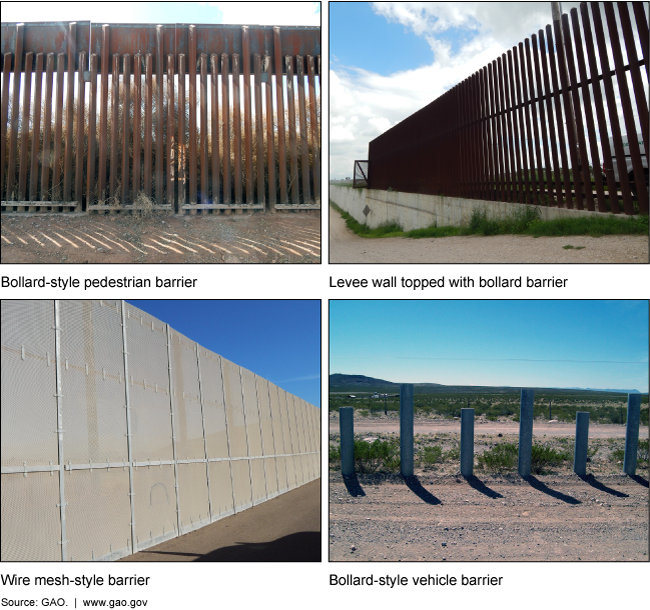Border Security: Assessment of the Department of Homeland Security's Border Security Improvement Plan
Fast Facts
Customs and Border Protection manages about 7,000 miles of land border and 95,000 miles of shoreline. The agency is required to produce a plan to help guide its efforts and include information on how it intends to use personnel, fencing, and technology.
However, we found that CBP's 2018 Border Security Improvement Plan does not include all of the information required by Congress. For example, the plan includes CBP's goals and objectives but lacks complete information on costs. It also doesn't explain how projects will address the highest priority security needs.
We recommended that CBP ensure the 2019 plan include all required elements.
Types of Physical Barriers Along the Southwest Border

Four types of border barriers.
Highlights
What GAO Found
The 2018 Border Security Improvement Plan includes some, but not all, of the elements required by the Department of Homeland Security (DHS) Appropriations Act, 2018. More specifically, the act set forth 11 required elements for the Border Security Improvement Plan, such as for the plan to include a statement of goals and objectives, a detailed implementation schedule, analyses of alternatives, an identification of staffing requirements, and a description of performance metrics, among other things. U.S. Customs and Border Protection (CBP), within DHS, includes some of these elements in the plan. For example, the plan includes CBP's border security initiatives, which it links to its goals and objectives. Likewise, it also includes a description of how CBP measures performance and a reference to other plans where additional detail can be found.
However, the plan does not include many of the other required elements or discuss why those elements were not included in the plan. Specifically, the plan does not provide estimates for the planned obligation of funds through 2027. It also does not include information on all its completed and planned life cycle cost estimates or how the projects under the plan will address the highest priority border security needs. The plan provides CBP's definition of an alternatives analysis, but otherwise does not provide information on alternatives analyses it is conducting or has conducted. Moreover, the plan does not include an assessment of the effects of infrastructure deployment on communities and property owners.
CBP officials stated that the Border Security Improvement Plan may not have included all of the act's required elements because the timing of each fiscal year's appropriation presents challenges in preparing the plan, such as limited time to engage in planning activities. The DHS Appropriations Act, 2019, includes a requirement for DHS to provide Congress and GAO with a risk-based plan for improving border security that includes the same 11 elements required by the 2018 DHS Appropriations Act. Ensuring that the 2019 Border Security Improvement Plan includes the statutorily required elements, or notes why any element was not included, would better position CBP to provide Congress with useful information for overseeing CBP's border security efforts and holding CBP accountable for results.
Why GAO Did This Study
Within DHS, CBP is the lead law enforcement agency responsible for border security. The DHS Appropriations Act, 2018, required the Secretary of Homeland Security to concurrently submit to the House and Senate Appropriations Committees and GAO a risk-based plan for improving security along the borders of the United States, including how CBP intends to use personnel, fencing, other forms of tactical infrastructure, and technology. The act sets forth 11 required elements for this plan—called the Border Security Improvement Plan. The Act also requires GAO to evaluate the plan and report to the appropriations committees on the strengths and weaknesses of the plan. This report addresses the extent to which the Border Security Improvement Plan includes the elements required by the DHS Appropriations Act, 2018. GAO reviewed the 2018 and 2017 plans, as well as other DHS, CBP, and Border Patrol strategic planning documents and guidance. GAO also interviewed officials from CBP and Border Patrol to discuss the report's required elements.
Recommendations
GAO recommends that CBP ensure the fiscal year 2019 Border Security Improvement Plan includes the statutorily required elements, or discloses why any element was not included. DHS concurred with this recommendation.
Recommendations for Executive Action
| Agency Affected | Recommendation | Status |
|---|---|---|
| Department of Homeland Security | The Secretary of Homeland Security should ensure that the fiscal year 2019 plan includes the statutorily required elements or discloses why any element was not included in the plan. (Recommendation 1) |
In July 2019, we reported on our assessment of the 2018 plan and found that it included some but not all of the 11 required elements. We recommended that DHS address all of the elements in its subsequent plan or provide information on why certain elements are not included. DHS agreed with our recommendation. In August 2020, DHS released the Fiscal Year 2019-2020 Border Security Improvement Plan. In response to our recommendation, DHS included an appendix in the 2019-2020 Plan with a summary table identifying each required element and its assessment of whether the element was satisfied, which addressed the intent of our recommendation. GAO is closing this recommendation as implemented.
|
